Main Menu
Become a Member

Sponsor a
"Taste of Torah"
weekly net-mag
The Kosher Culture
Handbook

Quick Links |
|
|
KCF Hebrew |
KCF Russian |
KCF Spanish |
KCF French |

|
 |
The tricolor flag of Lithuania was adopted on Aug. 1, 1922. It was long suppressed under Soviet rule until its reestablishment on March 20, 1989. The yellow color suggests ripening wheat and freedom from want. Green is for hope and the forests of the nation, while red stands for love of country, sovereignty, and valor in defense of liberty. |
|
|
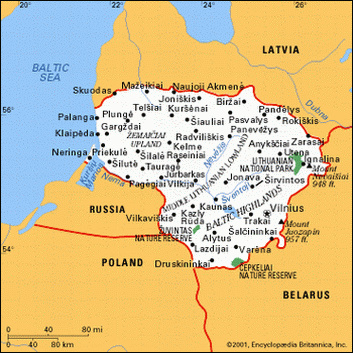 |
| Demography: |
|
Jews (1938): 155,000
[6.6% of population]
Jews (2007): ±5000
[.001% of population] |
Key Cities
with Jewish History |
|
|
|
" Encyclopædia Britannica World Atlas ." Encyclopædia Britannica . 2007. Encyclopædia Britannica Premium Service. 28 Nov. 2007 http://www.britannica.com/eb/atlas
© 2001 by Merriam-Webster, Incorporated; http://www.m-w.com/maps/moremapsnyt.html
Famous Rabbis
Famous Rabbis
of Lithuanian origin
or parentage |
|
|
Landmarks
Jewish Historic
Sites, Synagogues,
Museums & Landmarks |
| |
|
|
|
Pre-war, there were 100 synagogues in Vilnius. This one, built in 1905,
is the only one left.
|
|
|
|
| |
|
|
|
|
| |
|
|
|
|
2a Auku St., LT- 01113, Vilnius.
Tel.: +370-5-2496264 (guides), +370-5-2497427(director Eugenijus Peikstenis). Fax +370-5-2497427.
E-mail: muziejus@genocid.lt
|
|
|
|
|
Agrastu 17, tel. 641-847. Open 11:00-18:00. Closed Tuesdays and Sundays. Eight kilometers from Vilnius, just outside the village of Paneriai.
|
| |
|
|
|
Pylimo 4; Vilnius , Lithuania
Tel: +370-5-2616253
Fax: +370-5-2611946
email: j.museum@jmuseum.w3.lt
Hours: Sun-Thu 10 am-2 pm
|
| |
|
|
Exposition of Holocaust |
Pamenkalnio 12; Vilnius, Lithuania Tel: +370-5-2620730
Fax: +370-5-2127083
email: jewishmuseum@jmuseum.lt
Hours: Mon-Thu 9 am - 5 pm;
Sun 10 am - 16 pm
|
|
|
Naugarduko 10/2
Vilnius, Lithuania Tel: +370-5-2312354 +370-5-2312357
Fax: +370-5-2312358
e-mail: gajane.leonenko@jmuseum.lt
Hours: Mon-Thu 10am-6pm ;
Sun 10am-4pm
|
|
Streets of Vilna Ghetto today |
|
| |
|
|
Sv. Jokubo Str 17, Druskininkai
tel: (37033) 56 077 |
| |
|
Lithuanian National Library:
Judaica Department |
Martynas M. Mazvydas Library
Judaica Department
Ms. Fira Bramson; Vilnius, Lithuania
tel. (370 5) 2398 699 |
| |
TOP |
|
|
Historic Figures
Famous Jews
of Lithuanian origin
or parentage |
| |

|
|
Oligarch & owner of Chelsea F.C.
|
|
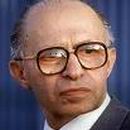
|
|
|

|
|
biochemist, Nobel laureate 2002
|
|

|
|
Russian-born French artist
|

|
| |

|
|
Canadian singer-songwriter,
poet and novelist
|
|

|
|
|
|

|
|
singer-songwriter, author,
musician and poet
|
|
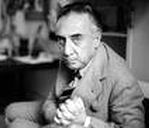
|
|
|
|

|
|
|
|
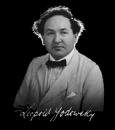
|
|
|
|

|
|
1991 Nobel Prize for literature
|
|

|
|
|
|
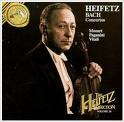
|
|
acclaimed 20th century violinist
born in Vilnius
|
| |

|
|
|
|

|
|
biophysicist, Nobel laureate 1982
|
|

|
|
|
|

|
|
|
|
sculptor |
| |
|
Emmanuel Lubezki |
3 times Academy Award nominee, cinematographer
|
|
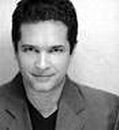
|
Sergio Lubezky |
Latin American photographer
|
|

|
|
|
|
|
|
|
|
|
|
|

|
Maury Povich |
|
|
.jpg)
|
P!nk, (Alecia Moore) |
US musician,
maternal Lithuanian Jewish ancestry
|
|

|
L.L. Zamenhof |
|
|

|
|
|
|
|
|
|
|
|
|
|
Maxima Market |
Mindaugo Street 6, Vilnius -
has a kosher food section |
| |
| |
| Chabad House |
| Shaltinju st. 13; Vilnius, 2007 Lithuania |
| Phone: |
370-5-215-03-87/89 |
| Fax: |
370-5-215-03-90 |
| Web: |
www.fjc.ru/vilnius |
|
Chabad House sells kosher food and provides a kosher dinner to travelers after Friday night services. |
| Rabbi Sholom Ber Krinsky, Director |
| |
| |
|
Chabad Soup Kitchen
and Humanitarian Aid Center |
| Shal'tinju st. 12; Vilnius, 2006 Lithuania |
| |
| |
TOP |
| |
| Judaica ~ Books |
| |
| |
| |
| |
TOP |
|
|
|
|
Pylimo St. 4; 2001 Vilnius, Lithuania
tel.: (3702) 613 003 | fax: (3702) 227 915
e-mail: office@litjews.org
Office hours: Mon. - Fri.; 10 am - 5 pm |
|
Small Childrens' Club "Dubi" |
|
|
|
|
|
The Union of Jewish Students and Youth in Lithuania |
|
|
|
|
Sunday Lectures |
Lectorium headed by Ms. Frida Zimaniene and Dr. Israel Lempert
Pylimo St. 4; 2001 Vilnius, Lithuania
tel.: (3702) 613 003, (3702) 227 917
fax (3702) 227 915
e-mail: jewishcom@post.5ci.lt |
| |
The Union of Former Ghetto and Concentration Camps' Prisoners |
Chairman: Tobijas Jafetas
Pylimo St 4, 2001 Vilnius, Lithuania
tel. (3702) 227 074 | fax (3702) 227 915
e-mail: office@litjews.org |
| |
The Union of the Second World War Veterans |
The Women's Zionist Organization WIZO |
President: Rochl Kostanian
Pylimo St 4, 2001 Vilnius, Lithuania
tel. (3702) 611 736 | fax (3702) 227 915
e-mail: office@litjews.org |
| |
| Jerusalem of Lithuania - Newspaper |
Author and editor - Milan Chersonskij
Pylimo Street 4
2001 Vilnius, Lithuania
tel.: (3705) 2127917, (3705) 2613003
fax (3705) 2127917
e-mail: jeruzale@litjews.org |
| |
| Lithuanian Jewish Community |
|
| |
| First World Litvak Congress |
Dr. Simon Alperovitch - Chairman
Pylimo St. 4; 2001 Vilnius, Lithuania
tel.: (+3702) 613 003 | fax: 227 915
e-mail: litvaks@litjews.org |
| |
| Chabad House: Vilnius |
| Shaltinju st. 13; Vilnius 2007 Lithuania |
| Phone: |
370-5-215-03-87/89 |
| Fax: |
370-5-215-03-90 |
| Web: |
www.fjc.ru/vilnius |
|
| Rabbi Sholom Ber Krinsky, Director |
|
Camp Gan Israel
contact/address as above |
|
Tzivos Hashem-Sunday School
contact/address as above |
 Yeshiva
contact/address as above |
Kindergarten |
| Brolyu str. 16; Vilnius, 2006 Lithuania |
| Phone: |
(370 5) 216-47-49, 216-60-73 |
|
|
Jewish Day School Beit Menachem |
| Brolyu str. 16; Vilnius, 2006 Lithuania |
| Phone: |
(370 5) 216-47-49, 216-60-73 |
| Fax: |
370-2-625-836 |
| Web: |
www.fjc.ru/vilnius |
|
The Rohr Family Mikvah
 |
| Dugshokha st. 3/2-10 Vilnius, 2000 Lithuania |
| Phone: |
370-5-215-0387 |
| Fax: |
370-2-625-836 |
|
|
| Mrs. Nechama Dina Krinsky, Director |
| |
TOP |
|
|
Lithuanian Airlines: |
|
| |
|
Tours of Jewish Vilnius: |
|
West Express; tel. 222-500, office@westexpress.lt |
Catastrophe Exhibition; tel. 620-730
|
|
History of Jewish Vilna; tel. 342-488 |
|
|
| |
|
|
|
P.O.B. 277; 03002, Vilnius; Lithuania
Tel. +370 5 2333716
Mob: +370 6 9990709 |
| |
|
King David Interstate Baltic Tours |
email: aroncik@kdbaltic.com info@kdbaltic.com
tel: 8(5)2659096 skype: kdbaltic
mob. tel : +37067109446
A.Vivulskio Str. 14/8-12, LT-03221 Vilnius, Lithuania kdbaltic.com |
| |
TOP |
| |
|
| |
|
|
Chairperson: M. Vainermanaite
Vytauto St. 19-15; Druskininkai, Lithuania
Tel. (37033) 54 590 |
| |
|
Jewish Community of Kaunas
|
Chairman: Gertsas Zhakas
Gedimino St. 26b; Kaunas 3000, Lithuania
Tel. (3707) 203 717 | Fax (3707) 201 135
e-mail: kzb@pub.vdu.lt
Office Hours: Monday to Friday 10-12 and 13-17 o'clock. |
| |
Jewish Community of Klaipeda |
Chairperson: Anna Glushko
Zhiedu skg. 3; Klaipeda, Lithuania
Tel./fax: (3706) 493 758 |
| |
Jewish Community of Plunge |
Chairman: Jakov Bunka
V. Macernio St. 6-16; Plunge, Lithuania
Tel. (37018) 52156 |
| |
Jewish Community of Ponavezhis |
Chairman: A. Fainblumas
Sodu St. 6-22, 5300; Panevezhys, Lithuania
Tel. (3705) 46 88 48 |
| |
Jewish Community of Shiauliai |
Chairman: Boris Shteinas
P.Vishinskio St. 24
5400 Shiauliai, Lithuania
Tel. (3701) 426 796 | Fax (3701) 426 678 |
| |
|
Chairperson: B. Katz
Vilniaus St. 5-7; Shvenchionys, Lithuania
Tel. (37017) 51 930 |
| |
|
Jewish Community of Telmay |
10a Rambino St. apt. 16
Telmay, Lithuania |
| |
|
Jewish Community of Ukmerge |
41a Bugenu St. apt. 15
Ukmerge, Lithuania |
| |
|
|
|
TOP |
|
Lithuanian History Timeline
|
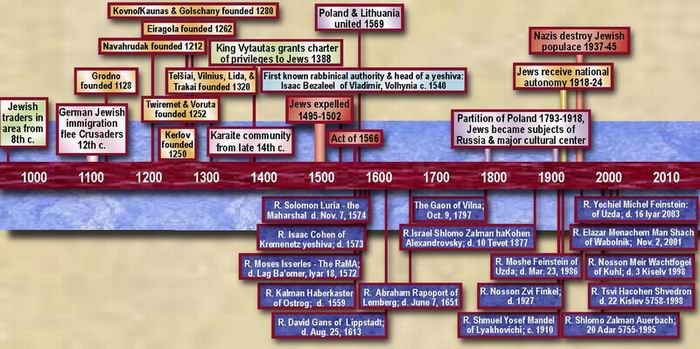 |
TOP
|
|
The History of the Jews in Lithuania spans the period from the eighth century to the present day. There is still a small community in that country, as well as an extensive Lithuanian Jewish diaspora in Israel, the United States and other countries. |
Early History |
As early as the eighth century Jews lived in parts of the Lithuanian territory. Beginning with that period they conducted the trade between Russia, Lithuania, and the Baltic, especially with Danzig, Julin (Vineta or Wollin, in Pomerania), and other cities on the Vistula, Oder, and Elbe. The origin of the Lithuanian Jews has been the subject of much speculation. It is believed that they were made up of two distinct streams of Jewish immigration. The older and significantly smaller of the two entered the territory that would later become the Grand Duchy of Lithuania from the east. These early immigrants spoke Judeo-Slavic dialects which distinguished them from the later Jewish immigrants who entered the region from the Germanic lands. While the origin of these eastern Jews is not certain, historical evidence places Jewish refugees from Babylonia, Palestine, the Byzantine Empire and other Jewish refugees and settlers in the lands between the Baltic and Black Seas that would become part of the Grand Duchy of Lithuania. The later and much larger stream of immigration originated in the twelfth century and received an impetus from the persecution of the German Jews by the Crusaders. The traditional language of the vast majority of Lithuanian Jews, Yiddish, is based largely upon the Medieval German and Hebrew spoken by the western Germanic Jewish immigrants. The peculiar conditions that prevailed in Lithuania compelled the first Jewish settlers to adopt a different mode of life from that followed by their western co-religionists. In the Lithuania of that day there were no cities in the western sense of the word, no Magdeburg Rights or close guilds. |
TOP |
Increasing Prosperity and the Great Charter
(1320-1432) |
With the campaign of Gediminas and his subjection of Kiev and Volhynia (1320-1321) the Jewish inhabitants of these territories were induced to spread throughout the northern provinces of the Grand Duchy of Lithuania. The probable importance of the southern Jews in the development of Lithuania is indicated by their numerical prominence in Volhynia in the thirteenth century. According to an annalist who describes the funeral of the grand duke Vladimir Vasilkovich in the city of Vladimir (Volhynia), "the Jews wept at his funeral as at the fall of Jerusalem, or when being led into the Babylonian captivity."
This sympathy and the record thereof would seem to indicate that long before the event in question the Jews had enjoyed considerable prosperity and influence, and this gave them a certain standing under the new régime. They took an active part in the development of the new cities under the tolerant rule of Gediminas.
Little is known of the fortunes of the Lithuanian Jews during the troublous times that followed the death of Gediminas and the accession of his grandson Vytautas (1341). To the latter, the Jews owed a charter of privileges which was momentous in the subsequent history of the Jews of Lithuania. The documents granting privileges first to the Jews of Brest (July 1, 1388) and later to those of Trakai, Grodno (1389), Lutsk, Vladimir, and other large towns are the earliest documents to recognize the Lithuanian Jews as possessing a distinct organization.
The gathering together of the scattered Jewish settlers in sufficient numbers and with enough power to form such an organization and to obtain privileges from their Lithuanian rulers implies the lapse of considerable time. The Jews who dwelt in smaller towns and villages were not in need of such privileges at this time, as Abraham Harkavy suggests, and the mode of life, the comparative poverty, and the ignorance of Jewish learning among the Lithuanian Jews retarded their intercommunal organization. But powerful forces hastened this organization toward the close of the fourteenth century. The chief of these was probably the cooperation of the Jews of Poland with their Lithuanian brethren. After the death of Casimir III (1370), the condition of the Polish Jews changed for the worse. The influence of the Roman Catholic clergy at the Polish court grew; Louis of Anjou was indifferent to the welfare of his subjects, and his eagerness to convert the Jews to Christianity, together with the increased Jewish immigration from Germany, caused the Polish Jews to become apprehensive for their future. |
TOP |
| The Charter of 1388 |
On this account it seems more than likely that influential Polish Jews cooperated with the leading Lithuanian communities in securing a special charter from Vytautas (Witold). The preamble of the charter reads as follows:
"In the name of God, Amen. All deeds of men, when they are not made known by the testimony of witnesses or in writing, pass away and vanish and are forgotten. Therefore, we, Alexander, also called Vytautas, by the grace of God Grand Duke of Lithuania and ruler of Brest, Dorogicz, Lutsk, Vladimir, and other places, make known by this charter to the present and future generations, or to whomever it may concern to know or hear of it, that, after due deliberation with our nobles we have decided to grant to all the Jews living in our domains the rights and liberties mentioned in the following charter."
The charter itself was modeled upon similar documents granted by Casimir the Great, and earlier by Boleslaw of Kalisz, to the Jews in Poland in 1084. Under the charter, the Lithuanian Jews formed a class of freemen subject in all criminal cases directly to the jurisdiction of the grand duke and his official representatives, and in petty suits to the jurisdiction of local officials on an equal footing with the lesser nobles (szlachta), boyars, and other free citizens. The official representatives of the grand duke were the elder (starosta), known as the "Jewish judge" (judex Judæorum), and his deputy. The Jewish judge decided all cases between Christians and Jews and all criminal suits in which Jews were concerned; in civil suits, however, he acted only on the application of the interested parties. Either party who failed to obey the judge's summons had to pay him a fine. To him also belonged all fines collected from Jews for minor offenses. His duties included the guardianship of the persons, property, and freedom of worship of the Jews. He had no right to summon any one to his court except upon the complaint of an interested party. In matters of religion the Jews were given extensive autonomy.
Under these equitable laws the Jews of Lithuania reached a degree of prosperity unknown to their Polish and German co-religionists at that time. The communities of Brest, Grodno, Trakai, Lutsk, and Minsk rapidly grew in wealth and influence. Every community had at its head a Jewish elder. These elders represented the communities in all external relations, in securing new privileges, and in the regulation of taxes. Such officials are not, however, referred to by the title "elder" before the end of the sixteenth century. Up to that time the documents merely state, for instance, that the "Jews of Brest humbly apply," etc. On assuming office the elders declared under oath that they would discharge the duties of the position faithfully, and would relinquish the office at the expiration of the appointed term. The elder acted in conjunction with the rabbi, whose jurisdiction included all Jewish affairs with the exception of judicial cases assigned to the court of the deputy, and by the latter to the king. In religious affairs, however, an appeal from the decision of the rabbi and the elder was permitted only to a council consisting of the chief rabbis of the king's cities. The cantor, sexton, and shochet were subject to the orders of the rabbi and elder.
The goodwill and tolerance of Vytautas endeared him to his Jewish subjects, and for a long time traditions concerning his generosity and nobility of character were current among them. His cousin, the king of Poland Jogaila, did not interfere with his administration during Vytautas's lifetime. |
TOP |
| The Union with Poland |
|
|
In 1569 Poland and Lithuania were united. It was generally a time of prosperity and relative safety for the Jews of both countries (with the exception of the Chmielnicki Uprising in the 17th century). However, a few events, such as the expulsion of the Jews from the Grand Duchy of Lithuania between 1495 and 1503 occurred just within Lithuania. This section will cover those events that occurred only within Lithuania. |
TOP |
| Expulsion of the Jews in 1495 and return in 1503 |
Casimir was succeeded as king of Poland by his son John Albert, and on the Lithuanian throne by his younger son, Alexander Jagellon. The latter confirmed the charter of privileges granted to the Jews by his predecessors, and even gave them additional rights. His father's Jewish creditors received part of the sums due to them, the rest being withheld under various pretexts. The favorable attitude toward the Jews which had characterized the Lithuanian rulers for generations was unexpectedly and radically changed by a decree promulgated by Alexander in April, 1495. By this decree all Jews living in Lithuania proper and the adjacent territories were summarily ordered to leave the country.
The expulsion was evidently not accompanied by the usual cruelties; for there was no popular animosity toward the Lithuanian Jews, and the decree was regarded as an act of mere willfulness on the part of an absolute ruler. Some of the nobility, however, approved Alexander's decree, expecting to profit by the departure of their Jewish creditors, as is indicated by numerous lawsuits on the return of the exiles to Lithuania in 1503. It is known from the Hebrew sources that some of the exiles migrated to the Crimea, and that by far the greater number settled in Poland, where, by permission of King John Albert, they established themselves in the towns situated near the Lithuanian boundary. This permission, given at first for a period of two years, was extended "because of the extreme poverty of the Jews on account of the great losses sustained by them." The extension, which applied to all the towns of the kingdom, accorded the enjoyment of all the liberties that had been granted to their Polish brethren (Cracow, June 29, 1498). The expelled Karaites settled in the Polish town of Ratno.
The causes of the unexpected expulsion were probably many, including religious reasons, the need to fill a depleted treasury by confiscating the Jews' money, personal animosity, and other causes.
Soon after Alexander's accession to the throne of Poland he permitted the Jewish exiles to return to Lithuania. Beginning in March, 1503, as is shown by documents still extant, their houses, lands, synagogues, and cemeteries were returned to them, and permission was granted them to collect their old debts. The new charter of privileges permitted them to live throughout Lithuania as before. The return of the Jews and their attempt to regain their old possessions led to many difficulties and lawsuits. Alexander found it necessary to issue an additional decree (April, 1503), directing his vice-regent to enforce the law. In spite of this some of the property was not recovered by the Jews for years. |
TOP |
| The Act of 1566 |
At the same time, the middle of the sixteenth century witnessed a growing antagonism between the lesser nobility and the Jews. Their relations became strained, and the enmity of the Christians began to disturb the life of the Lithuanian Jews. The anti-Jewish feeling, due at first to economic causes engendered by competition, was fostered by the clergy, who were then engaged in a crusade against heretics, notably the Lutherans, Calvinists, and Jews. The Reformation, which had spread from Germany, tended to weaken the allegiance to the Roman Catholic Church. Frequent instances occurred of the marriage of Catholic women to Jews, Turks, or Tatars. The Bishop of Vilna (Vilnius) complained to Sigismund August (Dec., 1548) of the frequency of such mixed marriages and of the education of the offspring in their fathers' faiths. The shlyakhta also saw in the Jews dangerous competitors in commercial and financial undertakings. In their dealings with the agricultural classes the lords preferred the Jews as middlemen, thus creating a feeling of injury on the part of the shlyakhta . The exemption of the Jews from military service and the power and wealth of the Jewish tax-farmers intensified the resentment of the shlyakhta . Members of the nobility, like Borzobogaty, Zagorovski, and others, attempted to compete with the Jews as leaseholders of customs revenues, but were never successful. Since the Jews lived in the towns and on the lands of the king, the nobility could not wield any authority over them nor derive profit from them. They had not even the right to settle Jews on their estates without the permission of the king; but, on the other hand, they were often annoyed by the erection on their estates of the tollhouses of the Jewish tax-collectors.
Hence when the favorable moment arrived, the Lithuanian nobility endeavored to secure greater power over the Jews. At the Diet of Vilna in 1551 the nobility urged the imposition of a special polltax of one ducat per head, and the Volhynian nobles demanded that the Jewish tax-collectors be forbidden to erect tollhouses or place guards at the taverns on their estates.
The opposition to the Jews was finally crystallized and found definite expression in the repressive Lithuanian statute of 1566, when the Lithuanian nobles were first allowed to take part in the national legislation. Paragraph Twelve of this statute contains the following articles:
"The Jews shall not wear costly clothing, nor gold chains, nor shall their wives wear gold or silver ornaments. The Jews shall not have silver mountings on their sabers and daggers; they shall be distinguished by characteristic clothes; they shall wear yellow caps, and their wives kerchiefs of yellow linen, in order that all may be enabled to distinguish Jews from Christians."
Other restrictions of a similar nature are contained in the same paragraph. However, the king checked the desire of the nobility to modify essentially the old charters of the Jews. |
TOP |
| Effect of the Cossacks' Uprising in Lithuania |
The fury of this uprising destroyed the organization of the Lithuanian Jewish communities. The survivors who returned to their old homes in the latter half of the seventeenth century were practically destitute. The wars which raged constantly in the Lithuanian territory brought ruin to the entire country and deprived the Jews of the opportunity to earn more than a bare livelihood. The intensity of their struggle for existence left them no time to reestablish the conditions which had existed up to 1648. John Casimir (1648-1668) sought to ameliorate their condition by granting various concessions to the Jewish communities of Lithuania. Attempts to return to the old order in the communal organization were not wanting, as is evident from contemporary documents. Thus in 1672, Jewish elders from various towns and villages in the grand duchy of Lithuania secured a charter from King Michael Wishnevetzki (1669-1673), decreeing "that on account of the increasing number of Jews guilty of offenses against the Shlyakhta and other Christians, which result in the enmity of the Christians toward the Jews, and because of the inability of the Jewish elders to punish such offenders, who are protected by the lords, the king permits the kahals to summon the criminals before the Jewish courts for punishment and exclusion from the community when necessary." The efforts to resurrect the old power of the kahals were not successful. The impoverished Jewish merchants, having no capital of their own, were compelled to borrow money from the nobility, from churches, congregations, monasteries, and various religious orders. Loans from the latter were usually for an unlimited period and were secured by mortgages on the real estate of the kahal . The kahals thus became hopelessly indebted to the clergy and the nobility.
In 1792 the Jewish population of Lithuania was estimated at 250,000 (as compared with 120,000 in 1569). The whole of the commerce and industries of Lithuania, now rapidly declining, was in the hands of the Jews. The nobility lived for the most part on their estates and farms, some of which were managed by Jewish leaseholders. The city properties were concentrated in the possession of monasteries, churches, and the lesser nobility. The Christian merchants were poor. Such was the condition of affairs in Lithuania at the time of the second partition of Poland (1793), when the Jews became subjects of Russia. |
TOP |
| Jewish Culture in Lithuania |
The founding of the yeshivot in Lithuania was due to the Lithuanian-Polish Jews who studied in the west, and to the German Jews who migrated about that time to Lithuania and Poland. Very little is known of these early yeshivot . No mention is made of them or of prominent Lithuanian rabbis in Jewish writings until the sixteenth century. The first known rabbinical authority and head of a yeshivah was Isaac Bezaleel of Vladimir, Volhynia, who was already an old man when Solomon Luria went to Ostrog in the fourth decade of the sixteenth century. Another rabbinical authority, Kalman Haberkaster, rabbi of Ostrog and predecessor of Luria, died in 1559. Occasional references to the yeshivah of Brest are found in the writings of the contemporary rabbis Solomon Luria (d. 1585), Moses Isserles (d. 1572), and David Gans (d. 1589), who speak of its activity. Of the yeshivot of Ostrog and Vladimir in Volhynia it is known that they were in a flourishing condition at the middle of the sixteenth century, and that their heads vied with one another in Talmudic scholarship. Mention is also made by Gans of the head of the Kremenetz yeshivah, Isaac Cohen (d. 1573), of whom but little is known otherwise.
At the time of the Lublin Union, Solomon Luria was rabbi of Ostrog, and was regarded as one of the greatest Talmudic authorities in Poland and Lithuania. In 1568 King Sigismund ordered that the suits between Isaac Borodavka and Mendel Isakovich, who were partners in the farming of certain customs taxes in Lithuania, be carried for decision to Rabbi Solomon Luria and two auxiliary rabbis from Pinsk and Tiktin.
The far-reaching authority of the leading rabbis of Poland and Lithuania, and their wide knowledge of practical life, are apparent from numerous decisions cited in the responsa. They were always the champions of justice and morality. In the Eitan ha-Ezrachi (Ostrog, 1796) of Abraham Rapoport (known also as Abraham Schrenzel; d. 1650), Rabbi Meïr Sack is cited as follows: "I emphatically protest against the custom of our communal leaders of purchasing the freedom of Jewish criminals. Such a policy encourages crime among our people. I am especially troubled by the fact that, thanks to the clergy, such criminals may escape punishment by adopting Christianity. Mistaken piety impels our leaders to bribe the officials, in order to prevent such conversions. We should endeavor to deprive criminals of opportunities to escape justice." The same sentiment was expressed in the sixteenth century by Maharam Lublin (Responsa, § 138). Another instance, cited by Katz from the same responsa , likewise shows that Jewish criminals invoked the aid of priests against the authority of Jewish courts by promising to become converts to Christianity.
The decisions of the Polish-Lithuanian rabbis are frequently marked by breadth of view also, as is instanced by a decision of Joel Sirkes (Bayis Hadash, § 127) to the effect that Jews may employ in their religious services the melodies used in Christian churches, "since music is neither Jewish nor Christian, and is governed by universal laws."
Decisions by Luria, Meïr Katz, and Mordecai Jaffe show that the rabbis were acquainted with the Russian language and its philology. Jaffe, for instance, in a divorce case where the spelling of the woman's name as Lupka or Lubka was in question, decided that the word is correctly spelled with a "b," and not with a "p," since the origin of the name was the Russian verb lubit = "to love," and not lupit = "to beat" (Levush ha-Butz we-Argaman, § 129). Meïr Katz (Geburat Anashim, § 1) explains that the name of Brest-Litovsk is written in divorce cases "Brest" and not "Brisk," "because the majority of the Lithuanian Jews use the Russian language." It is not so with Brisk, in the district of Kujawa, the name of that town being always spelled "Brisk." Katz (a German) at the conclusion of his responsum expresses the hope that when Lithuania shall have become more enlightened, the people will speak one language only— German —and that also Brest-Litovsk will be written "Brisk." |
TOP |
| Items from the Responsa |
The responsa shed an interesting light also on the life of the Lithuanian Jews and on their relations to their Christian neighbors. Benjamin Aaron Solnik states in his Mas'at Binyamin (end of sixteenth and beginning of seventeenth century) that "the Christians borrow clothes and jewelry from the Jews when they go to church." Sirkes (l.c. § 79) relates that a Christian woman came to the rabbi and expressed her regret at having been unable to save the Jew Shlioma from drowning. A number of Christians had looked on indifferently while the drowning Jew was struggling in the water. They were upbraided and beaten severely by the priest, who appeared a few minutes later, for having failed to rescue the Jew.
Luria gives an account (Responsa, § 20) of a quarrel that occurred in a Lithuanian community concerning a cantor whom some of the members wished to dismiss. The synagogue was closed in order to prevent him from exercising his functions, and religious services were thus discontinued for several days. The matter was thereupon carried to the local lord, who ordered the reopening of the building, saying that the house of God might not be closed, and that the cantor's claims should be decided by the learned rabbis of Lithuania. Joseph Katz mentions (She'erit Yosef, § 70) a Jewish community which was forbidden by the local authorities to kill cattle and to sell meat—an occupation which provided a livelihood for a large portion of the Lithuanian Jews. For the period of a year following this prohibition the Jewish community was on several occasions assessed at the rate of three gulden per head of cattle in order to furnish funds with which to induce the officials to grant a hearing of the case. The Jews finally reached an agreement with the town magistrates under which they were to pay forty gulden annually for the right to slaughter cattle. According to Hillel ben Herz (Bet Hillel, Yoreh De'ah , § 157), Naphtali says the Jews of Vilna had been compelled to uncover when taking an oath in court, but later purchased from the tribunal the privilege to swear with covered head, a practise subsequently made unnecessary by a decision of one of their rabbis to the effect that an oath might be taken with uncovered head.
The responsa of Meïr Lublin show (§ 40) that the Lithuanian communities frequently aided the German and the Austrian Jews. On the expulsion of the Jews from Silesia, when the Jewish inhabitants of Silz had the privilege of remaining on condition that they would pay the sum of 2,000 gulden, the Lithuanian communities contributed one-fifth of the amount.
The influence in communal life of prominent rabbinical scholars, such as Jaffe, Isserles, Luria, and Lublin, proved but a slight check to the growing misrule of the kahals. The individuality of the Lithuanian Jew was lost in the kahal, whose advantages were thus largely counterbalanced by the suppression of personal liberty. The tyranny of the kahal administration and the external oppression drove the great mass of the Lithuanian Jewry to seek consolation in the dry formalism of Talmudic precepts. The Talmud and its endless commentaries became the sole source of information and instruction. Every Jew was compelled by the communal elders to train his children in Talmudic lore. The Halakha offered a solution for every question in Jewish life, while the poetry of the Haggadah supplied alleviation for sorrow and hope for the future. Reformers arising among the Lithuanian Jews were forced by the kahal elders either to leave the community or to bend to the will of the administration. All was sacrificed to the inviolability of customs sanctioned by tradition or by the letter of the Law. The ties of friendship and family relationship were subordinated to the interests of the community. Hence it is little to be wondered at that the Kabbalah found fertile soil in Lithuania. The marked indications of approaching political anarchy were the chief causes of the organization of the Lithuanian Council. |
TOP |
| Vilna Gaon |
|
|
Religious observances owe greatly to Elijah ben Solomon (1720-1797), the Vilna Gaon, who lived in Lithuania's greatest city Vilnius. His style of Torah and Talmud study shaped the analytical "Lithuanian-style" form of learning still practiced in most yeshivas. The yeshiva movement itself is a typical Lithuanian development, initiated by the Vilna Gaon's main disciple, Rabbi Chaim Volozhin. |
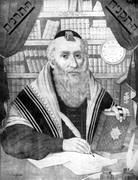 |
The Misnagdim were the early opponents of Hasidic Judaism, led by the Vilna Gaon who sharply denounced the innovations by the Hasidim. |
TOP |
| Lithuanian Jews under Russian Empire |
|
|
TOP |
Republic of Lithuania (1918-1940) |
Lithuanian Jews took active part in Freedom wars of Lithuania. Then on December 29, 1918 Lithuania's government called for volunteers to deffend Lithuanian state, from 10.000 volunteers there were more than 500 Jews. Altogether more than 3000 Jews served in Lithuanian army between 1918 and 1923. Initially, the Jewish community was given a wide amount of autonomy in education and taxation through community councils, or kehillot. By 1934, in a nationalist trend that reflected throughout Europe, the government scaled back much of this autonomy, and cases of antisemitism increased. During the Soviet annexation and occupation, cadres of communist Jews assumed significant roles int he NKVD and local communist nomenklatura. This was a common trend throughout the Soviet Union. Secular Jews, because of their literacy and prewar attachment to Communist ideals, became the visible image of the communist regime and were considered disloyal fifth columnists. Other Jews, particularly religious Jews and Zionists, were treated harshly by the Soviet-imposed communist government in Lithuania prior to the German invasion. Because of the depradations of the communist regime, some Lithuanians blamed Jews, took spontaneous actions against them, and otherwise participated in German-led campaigns of harassment and mass murder. It is impossible to disaggregate the identity of the victims and the motives of the perpetrators as originating in anti-Semitism, anti-Bolshevism, or some combination of both. |
TOP |
Second World War (Holocaust) |
The Lithuanian Republic was occupied by Soviet Union in 1940, and soon afterwards captured by the Nazis. The murder of Jews in the Baltic states started even before the Germans arrived. During World War II, 91% of Lithuanian Jews were killed by Germans and by the locals, almost all the Jews who had not managed to leave Lithuania and its environs. This was one of the highest casualty rates in the Holocaust.
The Choral Synagogue of Vilna, the only synagogue in the city to survive the Nazi holocaust and post-war Soviet oppression.
The only European yeshiva to survive the Holocaust was the Mir yeshiva. With help of the Japanese consul in Kaunas Chiune Sugihara, its leaders and students managed to escape to the Shanghai ghetto. |
|
|
| |
Soviet Era (1944-1990) |
Following the expulsion of Nazi German forces in 1944, The Soviets reannexed Lithuania as a Soviet republic, and prosecuted a number of Lithuanians for collaborating with the Nazis. Sites of wartime massacres, such as the Ninth Fort near Kaunas became monuments. To avoid nationalist themes, the memorials were declared in the name of all victims, though the clear majority of them are Jewish. Most survivors never returned, moving to Israel instead. Throughout Soviet rule, there was tension between the Jewish community and the authorities over the right to emigrate to Israel, and how to properly commemorate the Holocaust. The majority of Jews in Soviet Lithuania arrived after the war, with Russian and Yiddish as their primary language. |
TOP |
| |
| Further Reading |
| |
—Dov Levin, Adam Teller, The Litvaks: A Short History of the Jews of Lithuania, Berghahn Books, 2001, ISBN 9653080849
—Alvydas Nikžentaitis, Stefan Schreiner, Darius Staliunas, Leonidas Donskis, The Vanished World of Lithuanian Jews, Rodopi, 2004, ISBN 9042008504 |
| |
|
|
In part adapted from numerous Wikipedia articles about
"Jewish culture in Lithuania",
under the G.N U Free
Docmentation License.
Please also see http://en.wikipedia.org/wiki |
|
|
|
The Lithuanian national revival movement and initial struggle for liberation from Soviet oppression, which occurred at the end of the 1980s, also provided the conditions for Jewish national rebirth. Jewish cultural support groups began to be formed in many institutions and towns. On August 25, 1988 it was officially decided to create a Lithuanian Jewish Cultural Society, the founding meeting of which took place on March 5, 1989. |
TOP |
| Lithuanian Jews ~ Litvaks ~ Litvish |
|
| |
Etymology |
|
TOP |
| Ethnicity, Religious Customs and Heritage |
The characteristically "Lithuanian" approach to Judaism was marked by a concentration on highly intellectual Talmud study. Lithuania became the heartland of the traditionalist opposition to Hasidism, to the extent that in popular perception "Lithuanian" and "mitnagged" became virtually interchangeable terms. In fact, however, a sizable minority of Lithuanian Jews belong(ed) to Hasidic groups, including Chabad, Slonim, Karlin (Pinsk) and Koidanov. With the spread of the Enlightenment, many Lithuanian Jews became devotees of the Haskala movement in Eastern Europe, and today many leading academics, scientists and philosophers are of Lithuanian Jewish descent.
Lithuanian Jews are known in Yiddish as Litvak (noun) or Litvisher (adjective), or in Hebrew as Litaim. These terms are often used loosely to include those who follow the Lithuanian approach to Judaism (for example because they have attended Lithuanian-style yeshivas), whether or not their ancestors actually came from Lithuania: it seems that "Lithuanian-ness" can be transmitted spiritually as well as genetically.
The most famous Lithuanian institution of Jewish learning was Volozhin yeshiva, which was the model for most later yeshivas. "Lithuanian" yeshivas in existence today include Ponevezh, Telshe, Mir, Kelm, and Slabodka. In theoretical Talmud study, the leading Lithuanian authorities were Chaim Soloveitchik and the Brisker school; rival approaches were those of the Mir and Telshe yeshivas. In practical halakha the Lithuanians traditionally followed the Aruch HaShulchan, though today many prefer the more popular Mishnah Berurah. |
TOP |
Culture |
Litvaks have an identifiable mode of pronouncing Hebrew and Yiddish which is often used to determine the boundaries of Lita . Its most characteristic feature is the pronunciation of the vowel holam as [ey] (as against Sephardic /o/, Germanic [au] and Polish [oy]). In the popular preception, Litvaks were considered to be more intellectual and stoic than their rivals, the Galitzianers, who thought of them as cold fish. They, in turn, disdained Galitzianers as irrational and uneducated. Ira Steingroot's "Yiddish Knowledge Cards" devote a card to this "Ashkenazi version of the Hatfields and McCoys." [3] This difference is of course connected with the Hasidic/mitnagged debate, Hasidism being considered the more emotional and spontaneous form of religious expression. The two groups differed not only in their attitudes and their pronunciation, but also in their cuisine. The Galitzianers were known for rich, heavily sweetened dishes vs. the plainer, more savory Litvisher versions, with the boundary known as the " Gefilte Fish Line." [4] |
TOP |
| Jews in Lithuania today |
Interest among descendants of Lithuanian Jews has spurred tourism and a renewal in research and preservation of the community's historic resources and possessions. Increasing numbers of Lithuanian Jews are interested in learning and practising the use of Yiddish. [5] The beginning of the 21st century was marked by conflicts between members of Chabad-Lubavitch and secular leaders. In 2005, Chief Rabbi Sholom Ber Krinsky was physically removed from the Synagogue by two men hired by the community's secular leader Mr. Alperovich, who then declared a new Chief Rabbi. [6] Among notable contemporary Lithuanian Jews are the brothers Emanuelis Zingeris (a member of the Lithuanian Seimas) and Markas Zingeris (writer), Arkadijus Vinokuras (actor, publicist), Gercas Žakas (football referee), Bilas ( Gidonas Šapiro) (pop-singer from ŽAS), Dovydas Bluvšteinas (music producer), Leonidas Donskis (philosopher, essayist), Icchokas Meras (writer), Grigorijus Kanovicius (writer), Aleksas Lemanas (singer). |
TOP |
| Jewish Vilnius |
|
|
Jewish Street—or Zydu in Lithuanian—cuts through the heart of old town Vilnius. But there's not much overtly Jewish about it anymore. The Great Synagogue, which once stood at the end of Jewish Street (I-2), was dynamited by the Nazis and then later bulldozed by the Soviets; there's now a Soviet-built kindergarten and basketball court where the synagogue used to stand.
Most outward signs of the 600-year Jewish presence in this city were sadly obliterated as a consequence of the devastating 1941-44 German occupation. The Jewish ghetto was encircled by barbed wire and transformed into a prison camp for the city's 60,000 Jews, nearly all of whom were later marched to the Paneriai forest eight kilometers away and executed. Across Lithuania as a whole, some 200,000 Lithuanian Jews, or over 90 percent of the pre-war Jewish community perished. There are some 6000 Jews in Lithuania today, most of whom immigrated here from Russia during the Soviet era; there are fewer than 200 Holocaust survivors left in the country.
The first Jews came to Lithuania in the 14th century, lured to the area by tolerant Lithuanian Dukes. By the early twentieth century, half of the city's 120,000 strong population were Jews, most of whom spoke Yiddish—a 1000-year-old German dialect. Before the war, Vilnius was known as the Jerusalem of the North, acclaimed by Jews all across Europe for its Talmudic scholars, and for its thriving Yiddish-language theaters, libraries and schools that clustered around the close-knit 17th-century buildings of the Jewish quarter. Vilnius, or Vilna in Yiddish, was also home to the famed Yiddish Institute of Higher Learning (YIVO) and the Strashum Library, which housed the world's largest collection of Yiddish-language books; both were destroyed by the Nazis.
While it is true that few traces of the city's rich Jewish past survived the war, save for a few commemorative plaques (one is on Stikliu and another on Rudninku in the old city) there are ambitious plans for a Jewish revival of sorts. The legislature recently voted to restore and, in some cases, entirely rebuild scores of Jewish landmarks. The government is footing part of the bill, and a Jewish Cultural Fund was created to seek private donations for the project. Emanuelis Zingeris, a recent parliamentarian and chairman of the fund, said the restoration will be a fitting memorial. "We don't need another cemetery marker," he said. "We need a monument, not to how Jews died, but to how they lived. That's what this will be."
Easier tasks, like repainting Hebrew letters that once graced Jewish storefronts, have already begun. Rebuilding the cathedral-sized Great Synagogue, once the focal point of Vilnius Jewish life, will be harder-and far more costly; building the 3,000-square-meter synagogue from scratch will cost some 10 million dollars. The reconstruction of some 30 buildings in what are now parks and abandoned lots will cost some 90 million dollars more. "This restoration will be something Lithuanian parents can show their kids and say, 'Look here, this is our heritage. Great people once lived here,'" said Zingeris. "We need to bring this Jewishness back into the circulation of Lithuanian culture."
Vilnius's Jewish past still draws tens of thousands of Jewish visitors a year from the United States, Israel Argentina and also South Africa, where as many as 80 percent of the nation's 90,000 Jews descend from Lithuanian Jews, or litvaks. |
TOP |
|
|
The Lithuanian Government supports national communities, there is a special governmental institution that deals with issues concerning national minorities (The Department of National Affairs). A lot of laws, acts, resolutions have been passed that strive to ensure equal rights for everyone. All the Governments that ruled Lithuania in the past ten years, were and are favorable to Jews, support our activities. An example could be the State Commission that organized the jorzait of the Gaon. The Commission was set up by the special Decree of the President. Nonetheless the anti-Semitism is here, time to time it gets stronger. Anti-Semitic articles are published in certain newspapers, some of TV programs have a shade of anti-Semitism. Sometimes Jewish monuments or houses are desecrated by anti-Jewish slogans and symbols. During the last municipal elections the Mayor of Kaunas was elected N. Shustauskas, infamous for his anti-Semitic statements. Recently the Lithuanian National-socialistic party held its statutory meeting in Shiauliai. Its constitution in essence advocates the national-socialist ideas, however, they disguise it under a slightly changed name thus hoping to be easier registered at the Ministry of Justice.
The Lithuanian press publishes articles that condemn anti-Semitism, however, we think that Lithuanian intellectuals are not very active in this field. We especially lacked the weighty word of the Church, realizing that Lithuania is a catholic country and that people have great confidence in the Church. The Vatican document "We remember: Shoa reflections" has not been published in the press. However, recently, on April 14, 2000, the Lithuanian bishops published a statement of repentance. In the statement they apologize for the failure of the Church to do all that was in its power to prevent the believers from participation in the slaughter of Jews during the Nazi occupation. The statement also condemns anti-Semitism. We hope that this document will influence the moods of the society.
The Board of the Jewish Community of Lithuania constantly considers the problems of the fight against anti-Semitism. At the beginning of the running year we have prepared a sophisticated concept regarding the protection of Jews against anti-Semitism. |
The Lithuanian Government supports national communities, there is a special governmental institution that deals with issues concerning national minorities (The Department of National Affairs). A lot of laws, acts, resolutions have been passed that strive to ensure equal rights for everyone. All the Governments that ruled Lithuania in the past ten years, were and are favorable to Jews, support our activities. An example could be the State Commission that organized the jorzait of the Gaon. The Commission was set up by the special Decree of the President. Nonetheless the anti-Semitism is here, time to time it gets stronger. Anti-Semitic articles are published in certain newspapers, some of TV programs have a shade of anti-Semitism. Sometimes Jewish monuments or houses are desecrated by anti-Jewish slogans and symbols. During the last municipal elections the Mayor of Kaunas was elected N. Shustauskas, infamous for his anti-Semitic statements. Recently the Lithuanian National-socialistic party held its statutory meeting in Shiauliai. Its constitution in essence advocates the national-socialist ideas, however, they disguise it under a slightly changed name thus hoping to be easier registered at the Ministry of Justice.
The Lithuanian press publishes articles that condemn anti-Semitism, however, we think that Lithuanian intellectuals are not very active in this field. We especially lacked the weighty word of the Church, realizing that Lithuania is a catholic country and that people have great confidence in the Church. The Vatican document "We remember: Shoa reflections" has not been published in the press. However, recently, on April 14, 2000, the Lithuanian bishops published a statement of repentance. In the statement they apologize for the failure of the Church to do all that was in its power to prevent the believers from participation in the slaughter of Jews during the Nazi occupation. The statement also condemns anti-Semitism. We hope that this document will influence the moods of the society.
The Board of the Jewish Community of Lithuania constantly considers the problems of the fight against anti-Semitism. At the beginning of the running year we have prepared a sophisticated concept regarding the protection of Jews against anti-Semitism. |
TOP |
|
|
Local Jewish community — both the elderly and youngsters — enjoy celebrating traditional Jewish holidays. Such events attract large audience. The holidays became an important tool in the strengthening of national identity.
There is a Jewish school in Vilnius, named after the great Yiddish writer Sholom Aleichem. It is a state school, i.e. funded by the state. In addition to general curriculum, there are Judaic subjects — Tanach, Hebrew, history Jewish people — that play essential role in the teaching program. The school has almost 200 pupils. There are Sunday schools in Kaunas, Shiauliai, Klaipeda.
There is also a private religious school in Vilnius, supported by Chabad Lubavich community. This community has a rabbi. There are also very small misnagdim communities in Vilnius and Kaunas. They are visited by a rabbi from London several times in a year. Synagogues are open in Vilnius and Kaunas, whereas Klaipeda has a prayer home.
The Jewish Community of Lithuania attaches exceptional importance to the revival of cultural legacy. This work is extremely complicated not only due to the lack of funds, but also due to the fact that there is only a handful of Judaica specialist left in Lithuania. Nonetheless huge work is being accomplished. First of all, we must mention events, organized on certain occasions. Among them the most significant in scale and impact on society was the 200th jorcait of the Gaon of Vilnius. It would not be an exaggeration to claim, that the whole Lithuania lived under the influence of this great scholar for the entire week of celebrations.
Various conferences are organized. Their proceedings are usually published. In the course of the past ten years there were four large international conferences alone, and many more small ones. The Program in Judaic studies is open at Vilnius University. Courses on Jewish history and Holocaust are given in four universities in Vilnius, Kaunas, and Klaipeda (presented by Lithuanian scholars).
For ten years the Community has been holding the Jewish lectorium. Each Sunday people gather to listen to lectures, which often conclude with concerts. Sometimes these concerts are performed by litvaks — emigrants, who come back to visit their homeland.
Another cultural institution is the Jewish Cultural Club that reaches out to the Jewish and non-Jewish intellectuals.
The Community affiliates a very active children and youth club Ilan, as well as a club for the elderly Abi men zet zich.
There is a Judaica sector at the National Mazhvydas library. It catalogues Judaica publications in Yiddish and Hebrew which survived the Holocaust (the sector has in its disposition 50.000 books, as well as numerous newspapers and magazines).
Recently the Community opened a web site dedicated to the cultural heritage of Lithuanian Jews. Its URL is: http://litvakai.mch.mii.lt. The site is in Lithuanian and English.
An important role in our cultural life plays the fourlingual (in Yiddish, Lithuanian, Russian and English) newspaper Jerusalem of Lithuania.
This summer will welcome the Fourth Annual Vilnius Program in Yiddish (find more information at www.yiddishvilnius.com). Before the Catastrophe Vilnius was a center of Yiddish culture, therefore this program bears huge importance for current residents. |
TOP |
| The Judaica Department at the National Library |
TOP |
Lithuania was famous for its Jewish publishing houses. Since 1896 the Russian Empire allowed only two Hebrew publishing houses on its territory. One was located in Kiev, another — in Vilnius.
The monopoly in Vilnius was held by the Romm publishing house that moved here from Gardin in 1799. From 1831 to 1940 this publishing house was called “The widow and brother Romm”. Other 5-6 publishing houses appeared later in the century. Huge Judaica treasures were accumulated at Strashun (about 35000), YIVO (about 40000), Mefitsei haskolah (about 55000), children (about 23000), schools', yeshivas, synagogues' libraries.
A motion regarding the establishment of the YIVO Institute in Vilnius was passed during the Berlin Conference in 1925. The Institute functioned until 1940. The same 1925-year witnessed the opening of the YIVO department in New York, which in 1940 became a successor of the Vilnius Institute. The Kletskin publishing house (founded in 1925) printed contemporary Jewish literature and translations from the languages all around the world for Jewish schools. This publishing house also printed the famous children's magazine “Grininke beimelech” (“Little green trees”). The Nazi occupation began on June 22, 1941. Already in August the Rozenberg headquarters decided on the fate of Judaica books. The main objective of the fascists was to destroy as many Judaica books as possible and the most valuable volumes were to be transported to Germany. The sorting of the books was entrusted to a group of ghetto intellectuals who performed heroic feats by saving volumes, manuscripts, newspapers, smuggling and hiding them in the ghetto. The work was headed by Abraham Sutskever, Shmerke Katcherginski, the Director of the Ghetto library Herman Kruk, bibliograph Ch. Lunski, and assisted by Lithuanian intellectuals Ona Shimaite, Professor V. Birzhishka.
On September 10, 1941 the Ghetto library was established in the premises of the Mefitsei haskolah. About 100.000 volumes were given out to the readers by the end of 1942, therefore the majority of the saved books have the signs of this library.
After the war the rescued Judaica collection was stored in the Jewish Museum, which was closed in 1949. The books then were moved to the former Books' palace and rescued by the Mr. Antanas Ulpis, the Palace's director at that time. Today the Judaica department at M. Mazhvydas National Library stores about 50000 publications in Hebrew and Yiddish. Around 21633 of these were published in Lithuania, the remaining — abroad (2/3 of books are in Hebrew, 1/3 — in Yiddish).
All the books that were printed in Lithuania date back to 19th and beginning of 20th century. Various Talmud tractates were published since 1830-1840 (the oldest surviving dates back to 1835). The Torah, whose second edition (1831) survived, was also printed in Vilnius. Talmuds that were printed in Vilnius by the Romm publishing house are until nowadays reprinted in Jerusalem.
The Judaica department also has a catalogue of secular Hebrew literature. Among other books there are writings by a Kovner novelist A. Mapu (1808-1867) (his first books dates back to 1853), Vilner poets A. Lebenzon (1794-1878) and M. Lebenzon (1828-1852).
The end of 19th beginning of 20th century witnessed the formation of the literary Yiddish language. At that time Yiddish was a language of creation for such giants of modern Yiddish literature as novelists A. Dik (1807-1891), Mendele Moicher-Sforim (1836-1917), J.L.Perets (1851-1919), Sholom Aleichem (1859-1916), as well as members of “Yung Vilne” writers' group.
Department's visitors are especially interested in the collection of newspapers and magazines. We have 743 sets of 124 titles of newspapers and 3810 issues of 138 titles of magazines.
In 1995 the Department prepared an exhibition dedicated to the 70th anniversary of the founding of the YIVO Institute. Another exhibition was opened during the commemoration of the 200th death anniversary of the Gaon of Vilnius (1997). It presented 60 works by the prominent scholar and his disciples. What matters is not only the contents of the books. All volumes that are catalogued at the Department are also valuable as one large collection. They are survivors of horrible and tragic events. They became witnesses of the past. They tell the stories of libraries and the fates of their readers — people, who no longer are among us. 2005 |
TOP |
|
|
| The Past |
|
Lithuanian Jews created a unique religious and secular culture, which enriched the legacy of the world Jewry.
“In the past, Lithuanian Jews were spiritual leaders of the entire Jewry”, — recently noted rabbi Israel Meir Lau, the Chief Rabbi of Israel.
The fact that all over the world Vilnius became to be know as Jerusalem of Lithuania (and many call it Jerusalem of Diaspora) is a testimony to the recognition of the significant role of litvaks.
The Gaon of Vilnius, the famous Lithuanian yeshivas, the YIVO, the Romm publishers, the Strashun library, the Department of Semitic languages at the University of Vytautas the Great in Kaunas — these are only small bits of that majestic spiritual heritage of which we are proud.
The Nazi and their local accomplices destroyed that unique community. Lithuania was to become the first country in which the Nazi began the implementation of the final solution. Over 90% of almost quarter of a million Lithuanian Jews were murdered. Proportionally it is more than in any other country occupied by the Nazi. The policy of the genocide of Jewish culture that Stalin employed after the war, in essence concluded the annihilation of litvak legacy. |
| |
| The Present |
At the present, there are less than 5000 Jews in Lithuania. That is why, despite the fact that after the restoration of independence in 1990 discrimination against Jews was abolished and we exercise equal rights with the rest of country's citizens, as well as favorable conditions for the development of our culture, the situation still remains uncertain, there is a threat of extinction of Jewishness. Therefore the priorities of the Jewish Community of Lithuania, established in 1989 (up till November 17, 1991 it functioned as the Association of the Culture of Lithuanian Jews) are bringing Jews together under one roof, maintaining national identity, restoring Jewish cultural life, reviving from the ruins our cultural heritage.
In order to achieve this, we organize a wealth of events that are aimed at strengthening national consciousness. Among these we must first of all mention lectures, exhibitions, meetings etc. dedicated to Israel, its problems and holidays. All Israeli politicians, cultural, public figures, who come Lithuania on official or private visits, usually meet the members of the Community at Community's center. Such meetings always evoke large interest. |
TOP |
|
|
Welfare issues are also very important to the Lithuanian Jewish Community today, since they concern physical survival of our people. After the collapse of the Soviet Union, there was a wave of mass emigration. The majority repatriated to Israel. However, there were also a lot of those, and especially in the past several years, who left to Germany and USA. Due to this the demographic situation raises substantial problems. The majority of those who remain are pensioners, handicapped, and the unemployed. In addition, the economical crisis in Lithuania strips them of any weighty support from the state, except for minimal pensions, the largest portion of which goes to covering the bills for utilities and heating. Therefore help provided by the Community bears exceptional, vital importance. The Community has prepared a wide scale program of welfare services, that are provided to the most needy Jews in the first place. This program is being constantly developed. Every two months people receive food packages. The poorest can have free hot meals in a canteen. The handicapped receive meals on wheels. Some of the pensioners are supported monthly by monetary relief in the amount of $10.00 USD. For Pesach all pensioners receive 1 kilo of Matzah free of charge (one can buy more in the synagogue). From time to time we receive deliveries of charity clothes.
Since the majority of Jews are elderly, sick people, it is very important to provide them with medical care. The Community is affiliated with the Medical organization Ezra. Volunteer doctors from various specialties give qualified medical consultations free of charge. The fact that patients also receive medicines free of charge is crucial, since medications are very expensive and most of the elderly cannot afford them. |
| |
| Sponsors
All these activities would be impossible without generous and continuous support of the following sponsors: the American Joint Distribution Committee, the Conference on Jewish Material Claims Against Germany, the Baltic Jewish Forum, as well as other organizations and individuals. Without their help many members of the Lithuanian Jewish Community would be forced to starve. |
TOP |
|
|
The Second World Congress of Litvakes, which took place Aug. 24-30 under the banner "Litvak contribution to world culture", once again confirmed the fact that the Lithuanian Jewish Community (LJC) has become an important ethnic minority organization in the country, as well as the representative of Lithuanian Jewry in the community of world Jews. Several days after the closing of the Congress, an LJC member who is known for his particularly critical observations, stated that the Congress had been "something for all of us to celebrate".
The opening ceremony took place in the Great Hall of the Lithuanian National Philharmonic, which has welcomed quite a number of the 20th century's great musicians, starting with the Vilne wunderkind, Yascha Heifetz, who performed solo here in 1913. This was the starting point of his fabulous flight to the artistic heights of world music.
The flags of 12 nations representing the countries from which participants had arrived to attend the Congress hung in the foyer of the Philharmonic. They included Lithuania, Israel, USA, Great Britain, Canada, Republic of S. Africa, Australia, Sweden, Germany, Russia, Estonia and France. The stage was decorated with the flags of Lithuania and Israel, and above the silver organ pipes - the graphic emblem of the Congress. The Lithuanian National Symphony, conducted by artistic director Prof. Juozas Domarkas, played the national anthems of Lithuania and Israel, while Cantor Alberto Mizrahi sang. |
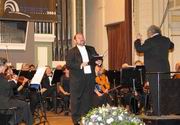 |
TOP |
| Litvak Contribution to World Culture |
In his greeting to the Litvakes who had come together for the Congress, chairman of the Lithuanian Jewish Community Dr. Simonas Alperavicius stated: "Generation upon generation of Jews would come to Vilnius, to Lithuania - to pray at the grave of the Vilna Gaon, to meet with celebrated rabbis, to visit Lithuania's yeshivas, YIVO, the Strashun Library - they would come to make contact with spiritual Jewish values". S. Alperavicius noted that "only after the restoration of Lithuania's independence were the Jews given an opportunity to have an independent Jewish community, to live a fully Jewish life, to be equal citizens of this country". |
TOP |
Lithuania Will Not Forget
the Tragedy of the Holocaust |
Congress participants heard a videotaped address by Lithuanian president Valdus Adamkus, who... stated that the Holocaust was not to be compared to any other tragedy, and that the land of Lithuania was drenched in the blood of thousands of innocent Jews.
"Lithuania will never forget this tragedy, - said the president. - This is crucial for us. And it is crucial for the world, so that similar horrors will never happen again." "Lithuania is proud that so many illustrious people were born here. - And added: - Only we do not yet know how to foster and strengthen ties with the talented and noble people who came from here, with you, the Litvakes." The president of Lithuania urged Litvakes from different countries to build relations with the land of their forefathers, to help Lithuania "to better know our common priceless treasure - the cultural heritage of Lithuania's Jews." |
TOP |
|
-
-
-
-
-
-
|
| |
| More Net Llinks |
|
|
|
|
|
|
|
|
|
|
|
|
|
|
|
|
|
|
|
|
TOP |
| More Resources on Lithuania |
|
|
|
| Jewish Revival in Lithuania 3.23.2004 |
|
|
|
|
|
TOP |
|
| Synagogues |
Judaica |
Prayer |
Acts of Kindness |
|
|
| |
|
|
|







